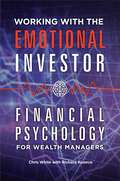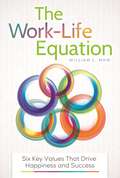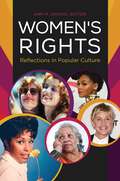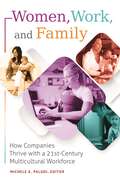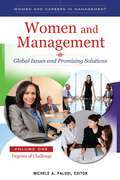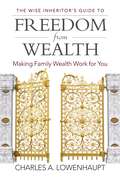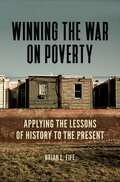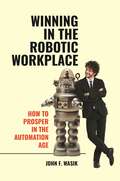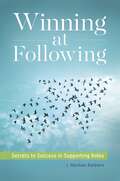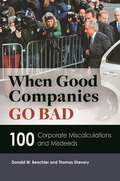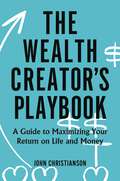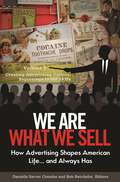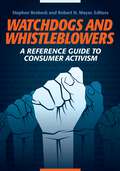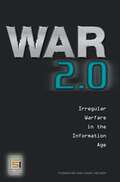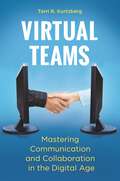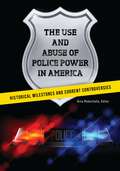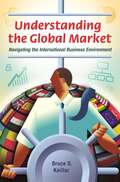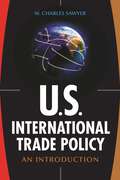- Table View
- List View
Working with the Emotional Investor: Financial Psychology for Wealth Managers
by Chris White Richard KoonceAn invaluable resource for wealth managers advising individuals, couples, and families, this book explains why human emotions drive all investor behavior and makes a powerful case for why advisors need to be aware of such emotions in advising clients—especially in high-stakes situations.Despite the fact that wealth advisors may employ algorithms, fancy financial models, economic theory, and predictive reasoning to forecast future investment returns, according to seasoned wealth management advisor Chris White, people—in other words, clients—basically decide how much risk to take with their money based on emotional factors such as the love they received as children, early life experiences of loss and "imperfect love," psychic wounds, and family traumas. A must-read for anyone in the wealth management profession, including wealth advisors, financial consultants, certified financial analysts, and retirement advisors, this groundbreaking book offers a radically new and well-articulated framework for managing relationships with clients as well as the essential tools to advise, mentor, and guide clients in making financial management decisions.Readers will understand how to recognize the emotional and psychological factors behind investor behavior and apply this insight to be a better wealth advisor. The author explains why early childhood experiences of love, joy, and loss and sometimes very subtle family dynamics play a key role in adult investor behavior; why being sensitive to an individual's unique psychological "systems" is key to being able to accurately assess his or her tolerance and acceptance of risk-taking as part of the wealth management process; what can cause a client's personality to change, especially in high-stress or high-stakes situations; and how to employ sophisticated client relationship management practices such as curiosity, appreciative inquiry, and powerful questioning to understand clients' needs at a deep psychological level.
Working with Millennials: Using Emotional Intelligence and Strategic Compassion to Motivate the Next Generation of Leaders
by Marc RobertsonThis book directly addresses the issues and problems that leaders face in today's business environment—and provides tangible and usable techniques to overcome these challenges.Millennial-generation managers and employees—those ages 18–35—have transformed business in America. More than any previous generation, they don't conform to the traditional ways of doing things. Rather than passively taking orders, Millennials thirst for engagement, expect to be part of a team, and need to be engaged in meaningful tasks. And they aren't as devoted to the corporation as much as they are to the product or service that's provided. This book guides readers—people in management positions or in any corporate setting—in embracing these key differences and nurturing their abilities to listen and empathize with coworkers, supervisors, and employees. Readers will also learn the best ways to encourage and motivate this unique generation in a way that is familiar to them and still serves to push them to work hard, improve, and grow.The book demonstrates how to lead and manage Millennials, explains how to motivate them, and describes how to help them develop professionally. It gives managers the tools and techniques to satisfy Millennials' need to advance rapidly in their careers—and explains how to become a supporter of this desire instead of appearing to stand in their way. Turning the traditional notion of business management on its head, it shows that taking a caring and humanistic approach to employees, coworkers, and colleagues leads to increased productivity, efficiency, and profitability. These same techniques that foster open communication and trust will help companies to create office cultures that encourage people to be self-motivated and minimize worker turnover.
The Work-Life Equation: Six Key Values That Drive Happiness and Success
by William L. MawThis book supplies a simple, memorable, and effective formula to solve problematic behaviors in the work environment and life in general. An invaluable guidebook, it will help readers move beyond mediocrity and achieve happier, more successful lives.The Work-Life Equation: Six Key Values That Drive Happiness and Success is for the millions of people and business managers who are surrounded by bad behavior—with its attendant mediocre or unsatisfying results—at work and in their private lives, but who hope and dream for happier and more successful lives. The book begins with a frank explanation of the need for self-awareness and self-improvement, then describes how the "winning formula" and the equation for happiness and success in work-life—(H,S) = f(4C,2R)—can be applied via six types of behaviors to effect sweeping changes. The formula means Happiness and Success can be achieved by (is a function of) Cooperation, Consideration, Compassion, Courtesy, Respect, and Responsibility. The book focuses not just on the meaning of these values but also on how to "better live" them. It concludes with a self-assessment tool for the individual, team, or organization to complete that enables objective measurements of behaviors and identification of areas of potential improvement.Dismissing the familiar, corporate value clichés, the author focuses on six key values most readers probably learned as kids but have forgotten about in adulthood—or didn't realize were still apt and relevant. The book provides priceless information and guidance for all readers but will be especially appreciated by those in the corporate workplace interested in self-improvement and success, educators and business students, executives looking to shift their firm's behavioral atmosphere in a positive direction, and individuals seeking inspiration and hope in their daily lives.
Women's Rights: Reflections in Popular Culture (Issues through Pop Culture)
by Ann M. Savage, EditorCovering from 1900 to the present day, this book highlights how female artists, actors, writers, and activists were involved in the fight for women's rights, with a focus on popular culture that includes film, literature, music, television, the news, and online media.Women's Rights: Reflections in Popular Culture offers a succinct yet thorough resource for anyone interested in the relationship between feminism, women's rights, and media. It is ideally suited for students researching popular culture's role in the modern history of women's rights and representation of women, women's rights, and feminism in popular culture. This insightful book highlights of some of the most important moments of women taking a stand for women throughout popular culture history.Each section focuses on an aspect of popular culture. The television section covers important benchmarks, such as Julia, The Mary Tyler Moore Show, Roseanne, Murphy Brown, and Ellen. Coverage of films includes Christopher Strong, Foxy Brown, and Thelma & Louise; the literature section features the work of influential individuals such as Virginia Woolf, Zora Neale Hurston, and Toni Morrison. The book celebrates early musical ground-breakers like Gertrude "Ma" Rainey and Bessie Smith as well as contemporary artists Janelle Monáe and Pussy Riot. The work of key women activists—including Margaret Sanger, Angela Davis, and Winona LaDuke—is recognized, along with the unique ways women have used the power of the web in their continued effort to push for women's equality.
Women, Work, and Family: How Companies Thrive with a 21st-Century Multicultural Workforce
by Michele A. PaludiA sweeping collection of new essays gathers historical background, theoretical perspectives, and the latest research on integrating work and personal life in a multigenerational workforce.A half-century after the women's movement of the 1960s, women still have not achieved equality in the workplace, in part because the burdens of family still fall largely upon their shoulders. This in-depth review examines legislation, social-science research, and human resources management practices dealing with women's integration of work and life roles. It explores the context and theory that explain new workplace trends and realities, and it offers practical recommendations on how women and companies can cope.The book is based on the premise that to attract and retain top talent and be competitive in the 21st century, employers must redesign their organizations to meet the needs of employees. A sort of "paper mentor" for women, it spells out the myths and realities of combining employment with motherhood and a committed relationship. The expert essays are also a guide for corporations, intended to help them understand the necessity of easing women's burdens—and nurturing their talent—through attention to work hours and to policies that can facilitate the integration of work and life roles.
Women in Media: A Reference Handbook (Contemporary World Issues)
by Amy M. DamicoThis title provides a broad overview of how women are portrayed and treated in America's news and entertainment industries, including film, television, radio, the internet, and social media.This book provides a one-stop resource for understanding the participation and representation of women in the U.S. media in such areas as narrative film, scripted television programming, advertising, video games, news, and sports. Coverage is wide-ranging and comprehensive, covering historical developments and trends as well as such relevant issues as gender disparities in pay and advancement opportunities, stereotypical gender portrayals in popular entertainment, sexual harassment in America's media and entertainment industries, and the dearth of positive media representations of women of color.Engaging with this history and reading about current issues related to this topic will be useful to those interested in understanding more about why women's engagement in media—in such roles as performer, journalist, producer, and writer—is important. It will also help readers better understand how and why problematic media representations of women hinder efforts to achieve full gender equality in American society.
Women and Management [2 volumes]: Global Issues and Promising Solutions [2 volumes] (Women and Careers in Management)
by Michele A. PaludiFor every woman still bumping the glass ceiling and every man who cares, these volumes recount challenges female leaders face—and strategies that will smooth the path to managerial positions in corporate America and worldwide.Expert contributors offer a global perspective on issues women leaders and managers must confront every day, from sex discrimination, sexual harassment, and gender mainstreaming to pay inequity and male perceptions of women leaders. Volume 1, Degrees of Challenge, addresses both overt and subtle biases women encounter in trying to meet their career aspirations. Volume 2, Signs of Solutions, offers concrete, empowering strategies for organizational change intended to eliminate discriminatory treatment of women in the workplace.The 30 research-based studies here are drawn from nations as disparate as the United States, Turkey, Puerto Rico, Australia, Japan, Great Britain, Israel, the Czech Republic, the Dominican Republic, India, Nepal, Korea, Sri Lanka, and Indonesia to showcase new and emerging solutions worldwide. Accounts from woman managers are also included to provide the reader with real-life examples of how women deal with organizations that welcome them—and those that hinder their performance.
The Wise Inheritor's Guide to Freedom from Wealth: Making Family Wealth Work for You
by Charles A. LowenhauptWealth should never consume or imprison the wealth holder, but it can. This book provides solutions to the issues many wealth inheritors encounter, including problems with trust, family wealth secrets, and family legacy.The next generation may witness one of the largest transfers of wealth in history. By one estimate, millennials and Generation Z are set to inherit $30 trillion over the next 30 years. The sudden inheritance of significant wealth creates a variety of challenges that seem counterintuitive and can be difficult to understand and deal with, making inheritors of wealth feel isolated from friends and colleagues. Meanwhile, the wealth industry is fed by revenue paid by wealth owners, not inheritors, causing misalignment of priorities and generational conflict.The Wise Inheritor's Guide to Freedom from Wealth helps readers to put their new wealth in perspective, preparing them to lead inspired lives of self-actualization and freedom. As a third-generation wealth counselor and industry leader, Charles A. Lowenhaupt has helped wealth creators and inheritors to manage almost every imaginable challenge, including marital tension, family dysfunction, and addiction. Few people actually have the knowledge and experience to figure out the purpose of wealth and set it on its course. In this book, he helps wealth inheritors to develop a healthy relationship with wealth at a young age, thus enabling readers to live in harmony with both their wealth and their families.
Winning the War on Poverty: Applying the Lessons of History to the Present
by Brian L. FifeApplying lessons from history to the reality of poverty today in the United States—the most affluent country in the world—this book analyzes contributing factors to poverty and proposes steps to relieve people affected by it.American history is replete with efforts to alleviate poverty. While some efforts have resulted in at least partial success, others have not, because poverty is a multifaceted, complicated phenomenon with no simple solution. Winning the War on Poverty studies the history of poverty relief efforts in the United States dating to the nineteenth century, debunking misperceptions about the poor and tackling the problem of the ever-widening gap between the rich and poor. It highlights the ideological differences between liberal and conservative beliefs and includes insights drawn from a well-rounded group of disciplines including political science, history, sociology, economics, and public health. Premised on the idea that only the lessons of history can help policymakers to recognize that the United States has a persistent poverty problem that is much worse than it is in many other democracies, the book suggests an 18-point plan to substantively address this dilemma. Its vision for reform does not pander to any particular ideology or political party; rather, the objective of this book is to explain how the United States can win the war on poverty in the short term.
Winning in the Robotic Workplace: How to Prosper in the Automation Age
by John F. WasikThis book will examine the history of robotics and explicate what massive automation means for the present and future of labor in all its forms, from mills and factories to the white-collars offices of suburbia and more.While warnings of a robot world-takeover could seem dramatic, the truth is more mundane—robots have come to take our jobs. Winning in the Robotic Workplace: How to Prosper in the Automation Age will teach you the skills needed to reprogram the way you work in anticipation of this technological shift. Author John F. Wasik believes learning to thrive in the automation age can in fact humanize the workplace once again. In Winning in the Robotic Workplace: How to Prosper in the Automation Age, you will learn to emphasize the conceptualization and pursuit of creative ideas, a practice that most robots are unequipped to perform in a meaningful way. You will learn that the successful integration of automated elements with humans is the most effective business model moving forward, and that an eagerness to collaborate demonstrates a will to succeed.
Winning at Following: Secrets to Success in Supporting Roles
by J. Norman BaldwinReplete with engaging stories and written in a down-to-earth style, this book provides the first and only road map for finding success and happiness in life's most common yet underrated role—that of the follower.What kinds of behaviors and responses do most bosses want from those they lead? Which jobs seem desirable and exciting but present work conditions in which followers are likely to fail or be unhappy? What's the best way to communicate bad and good news to a superior? Winning at Following: Secrets to Success in Supporting Roles answers these questions and covers many more topics that are highly relevant to everyone, for those who report to others as well as for managers, directors, CEOs, or other acting leaders. Individuals who are satisfied in their roles as followers will discover information that helps them to optimize their success and fulfillment at work, while dissatisfied followers—anyone struggling as a follower and searching for directions for positive change—will find this book extremely valuable as a road map to greater meaning, success, and satisfaction at work and in life.Readers will gain the critical direction and tools for fulfillment in their roles as followers—in whatever capacity that may be—and understand what they need to do to please their superiors as well as to solve the common problems and challenges that followers face. The book also explains how individuals can identify their followership style and discover the types of organizations where they are most likely to thrive. The final chapter provides guidance on how to overcome common, serious problems that followers experience, such as micromanaging bosses, sexual harassment, unethical directives from superiors, and disrespectful colleagues.
When Good Companies Go Bad: 100 Corporate Miscalculations and Misdeeds
by Donald W. Beachler Thomas ShevoryCovering the entire world of business from heavy industry to the financial houses of Wall Street, this book shines a spotlight on 100 of the most infamous cases of misconduct and malfeasance in corporate history.Corporations are in the business of making money. But when companies forget ethics, take operational shortcuts, or willingly endanger customers and the general public in their quest for profits, disasters of enormous magnitude can result. This book examines 100 of the worst cases of corporate greed and irresponsibility and poses the questions: Is it necessary or desirable to conduct business in this manner? Do the penalties and other punishments levied against these companies go far enough? And what is the government's responsibility for keeping corporate misdeeds in check?Coauthored by distinguished public policy experts, When Good Companies Go Bad: 100 Corporate Miscalculations and Misdeeds presents a representative sample of cases on a variety of topics, such as the financial sector, health care, environmental protection, product liability, and copyright. This broad introduction to the dark side of the corporate world focuses on events and scandals that resulted in substantial financial penalties, regulatory actions, or criminal convictions. The cases are presented in a readable and engaging format, making the book an illuminating and informative read for high school and college students as well as businesspeople, lawyers, journalists, and professors who teach American politics, public law, or public policy.
The Wealth Creator's Playbook: A Guide to Maximizing Your Return on Life and Money
by John ChristiansonAn advisor to many of today's most successful wealth creators explains how to align your values with your wealth, including the ways in which it is earned, managed, and spent, to maximize both wealth and personal fulfillment.Money is something most people fantasize about: if only financial independence became a reality, then life would be easier and more fulfilling. Wealth creators soon discover that while money provides incredible opportunities, it can also bring unexpected consequences: isolation, relationship challenges, and a lack of purpose that are often by-products of achieving financial success. Wealth is a gift that involves practical, psychological, and spiritual stewardship. Wealth creators desperately need advice they can trust to maximize, not just manage, the gift of wealth. Drawing on wisdom from John Christianson's 25 years of experience advising some of the most successful wealth creators in the country, this book explores money emotional intelligence, roadblocks around money and relationships, kids and money, generosity, identity, and aligning your values with your money. The Wealth Creator's Playbook is the go-to guide for individuals who are chasing financial success and the richness of a deeply fulfilling life.
We Are What We Sell [3 volumes]: How Advertising Shapes American Life. . . and Always Has [3 volumes]
by Danielle Sarver Coombs Bob BatchelorFor the last 150 years, advertising has created a consumer culture in the United States, shaping every facet of American life—from what we eat and drink to the clothes we wear and the cars we drive.In the United States, advertising has carved out an essential place in American culture, and advertising messages undoubtedly play a significant role in determining how people interpret the world around them. This three-volume set examines the myriad ways that advertising has influenced many aspects of 20th-century American society, such as popular culture, politics, and the economy. Advertising not only played a critical role in selling goods to an eager public, but it also served to establish the now world-renowned consumer culture of our country and fuel the notion of "the American dream."The collection spotlights the most important advertising campaigns, brands, and companies in American history, from the late 1800s to modern day. Each fact-driven essay provides insight and in-depth analysis that general readers will find fascinating as well as historical details and contextual nuance students and researchers will greatly appreciate. These volumes demonstrate why advertising is absolutely necessary, not only for companies behind the messaging, but also in defining what it means to be an American.
Watchdogs and Whistleblowers: A Reference Guide to Consumer Activism
by Stephen Brobeck & Robert N. MayerThis book is the most comprehensive and up-to-date source of information about ways in which consumer activism has reshaped the economic and political well-being of citizens in the United States and around the world.This all-encompassing collection of information about consumer activism and the consumer movement will provide students, public officials, business groups, and other activists with a one-stop source of facts and insights. The contributors explore hundreds of major consumer protections that have significantly enhanced the quality of life and safety for all Americans, showing how these protections were won through the skillful and determined work of leading activists and activist organizations. Many of the stories told here are related by the activists themselves, often for the first time.More than 140 entries offer a comprehensive treatment of the consumer activism of specific organizations, their leaders, and strategies. The book also includes more than 40 entries about consumer movements in Europe, Asia, Africa, and Latin America. A timeline of key events and a listing of the most important books on the subject of consumer activism help provide context for the individual entries as do two introductory essays. Cross references in each entry establish linkages among topics.
War 2.0: Irregular Warfare in the Information Age (Praeger Security International)
by Thomas Rid Marc HeckerWar 2.0: Irregular Warfare in the Information Age argues that two intimately connected grassroots trends—the rise of insurgencies and the rise of the web—are putting modern armies under huge pressure to adapt new forms of counterinsurgency to new forms of social war.After the U.S. military—transformed into a lean, lethal, computerized force—faltered in Iraq after 2003, a robust insurgency arose. Counterinsurgency became a social form of war—indeed, the U.S. Army calls it "armed social work"—in which the local population was the center of gravity and public opinion at home the critical vulnerability.War 2.0 traces the contrasting ways in which insurgents and counterinsurgents have adapted irregular conflict to novel media platforms. It examines the public affairs policies of the U.S. land forces, the British Army, and the Israel Defense Forces. Then, it compares the media-related counterinsurgency methods of these conventional armies with the methods devised by their irregular adversaries, showing how such organizations as al-Qaeda, the Taliban, and Hezbollah use the web, not merely to advertise their political agenda and influence public opinion, but to mobilize a following and put violent ideas into action.
Virtual Teams: Mastering Communication and Collaboration in the Digital Age
by Terri R. KurtzbergTo advance in today's workplace requires virtual team skills. Most individuals assume their face-to-face skills will translate, but competency with virtual communication and teamwork requires an entirely new set of skills. This book guides readers down the path to success.Electronic communication is now embedded in our daily experience, as is work involving off-site collaborators. Virtual communication has become an essential job skill that is critical to individual and group success, yet most people just muddle through it without giving it any thought. Drawing on decades of scientific research in the fields of psychology, organizational behavior, and sociology, this book explains how to master the art and science of communicating virtually.The author first analyzes the subtle but significant changes that result when conversations are moved online, providing examples and tips to avoid common pitfalls, then discusses how team behavior and decision making can best be guided in this realm. Readers will fully understand what makes teams "click"—what inspires trust, how to get a team "off on the right foot," and what steps to take in order to make good collaborative decisions—as well as other key topics for virtual teamwork, such as best practices for working in the cross-cultural environment. The book serves as an ideal guide for anyone who participates in or manages a virtual team but is also suitable as a supplemental textbook in a business school course on organizational behavior or business communication.
Violence in American Society [2 volumes]: An Encyclopedia of Trends, Problems, and Perspectives [2 volumes]
by Chris RichardsonWhile many books explore such specific issues as gun violence, arson, murder, and crime prevention, this encyclopedia serves as a one-stop resource for exploring the history, societal factors, and current dimensions of violence in America in all its forms.This encyclopedia explores violence in the United States, from the nation's founding to modern-day trends, laws, viewpoints, and media depictions. Providing a nuanced lens through which to think about violence in America, including its underlying causes, its iterations, and possible solutions, this work offers broad and authoritative coverage that will be immensely helpful to users ranging from high school and undergraduate students to professionals in law enforcement and school administration.In addition to detailed and evenhanded summaries of the key events and issues relating to violence in America, contributors highlight important events, political debates, legal perspectives, modern dimensions, and critical approaches. This encyclopedia also features excerpts from such important primary source documents as legal rulings, presidential speeches, and congressional testimony from scholars and activists on aspects of violence in America. Together, these documents provide important insights into past and present patterns of violent crime in the United States, as well as proposed solutions to those problems.
The Use and Abuse of Police Power in America: Historical Milestones and Current Controversies
by Editor Gina RobertielloProviding a timely and much-needed investigation of how U.S. law enforcement carries out its public safety and crime fighting mandates, this book is an invaluable resource for students, educators, and concerned citizens.Does America face an epidemic of police officers abusing their powers and disregarding constitutional rights, especially in communities of color? Or are such accusations unfair, especially given the enormous challenges of enforcing the law in 21st-century America? This book provides a unique frame of reference for understanding how some of the issues between the police and the public emerged, identifying events that have shaped current relationships between the police and the public, as well as the public's expectations and perceptions of the police.An authoritative resource for understanding modern law enforcement and its relationship with American communities, this volume addresses subjects including the legal underpinnings of various law enforcement actions and practices; the so-called militarization of police departments; the increased use of force and surveillance to combat crime and terrorism, and to generally "keep the peace"; and the perspectives of Black Lives Matter activists and other critics of American law enforcement. The entries provide readers with expert analysis of current topics related to the intensifying debate about the American police state; examine the scope of law enforcement issues that have existed for centuries, and explain why they continue to exist; and cover new mandates for exercising police power, enabling readers to critically analyze what is presented to them in the media. Included throughout the book are excerpts from important laws, speeches, reports, and studies pertaining to the subject of the use and abuse of police power in the United States
Universal Health Care (Health and Medical Issues Today)
by Claudio ButticèThis accessibly written book explains universal healthcare; the many forms it can take; and the issues, debates, and historical context underpinning the continued struggle for its implementation in the United States.Universal healthcare may be defined as any healthcare system that ensures at least basic coverage to most, if not all, citizens of a country. Although it may be implemented in many ways, universal healthcare has been widely accepted by international humanitarian organizations such as the World Health Organization (WHO) as the best way to ensure the universal human right to health. So why is the United States the only industrialized country without universal healthcare? What are the political, social, and economic factors that have prevented its successful introduction?Universal Healthcare explores what universal healthcare is, the many forms it can take—using examples from countries around the world—and the tumultuous history of attempts to implement a system of universal healthcare in the United States. Part II delves into the contentious issues and debates surrounding adoption of universal healthcare in the United States. Lastly, Part III provides a variety of useful materials, including case studies, a timeline of critical events, a glossary, and a directory of resources.
Understanding Violent Criminals: Insights from the Front Lines of Law Enforcement (Forensic Psychology)
by David J. ThomasWhat causes people to commit violent crimes? The case studies in this book enable readers to evaluate the motivations behind crimes ranging from arson to rape to gang violence.Violent crime remains a major problem in America: in 2011, there were more than 1.2 million violent crimes committed in the United States. To better grasp the complex reasons behind this disturbing statistic, author David J. Thomas—a police officer and forensic psychologist—conducted an in-depth examination of violent crime to pinpoint why some individuals intentionally inflict pain and suffering upon others. In this book, readers are given access to excerpts from police interviews for each spotlighted crime in the case studies, offering a unique inside look at the true motivations of the criminal. The case studies include examples of arson, crimes against children, gang violence, human trafficking, murder, rape, and robbery. The work also explores the psychology associated with each crime, addresses evidence of corresponding personality types, and delves into victimology.
Understanding the Global Market: Navigating the International Business Environment
by Bruce D. KeillorThis is an invaluable, applied "how to" guide to understanding the unique characteristics of the international business environment that provides critical information to all managers considering entering an overseas market.The global marketplace is a reality, yet there are virtually no books dedicated to understanding the international business environment. The accessible, practitioner-oriented information in this book provides businesspeople with the tools necessary to accurately analyze the complex global environment and the perspective to be successful in international markets.A resource for business managers as well as for college-level business students, the book covers all major areas of the international business environment, including the cultural aspects of international commerce environments as well as economic, political, and competitive challenges. Additionally, the author explains how a business entity can impact the market environment in which it operates.
Uber (Corporations That Changed the World)
by B. Yasanthi Perera Pia A. AlbinssonUber is one of the most innovative companies of our time. This book provides a detailed analysis of the company and its success and goes beyond the headlines about safety and culture.Americans are so accustomed to using Uber today that the name of the innovative ride-sharing company has almost become a verb, as in "to Uber" somewhere, and yet Uber has been around only since 2010. In less than a decade, Uber has disrupted the ride-hailing industry, from making it easier and more affordable to become an Uber driver than a cab driver to rating riders as well as drivers. As an early pioneer in using technology to create a new business model and new efficiencies, Uber is considered one of the most important case studies in the sharing economy. However, little in-depth information exists on this innovative company. This book traces Uber's origin and evolution in the face of competitive pressures, discusses the company leadership and corporate culture, addresses such controversies as rider and driver safety and sexual harassment of female employees, and explores how the company is addressing these challenges. Students of business, entrepreneurs, and anyone interested in the development and exponential growth of the sharing economy will benefit from reading this book.
U.S. Trade Issues: A Reference Handbook (Contemporary World Issues)
by Alfred E. Jr.An expert analysis of key issues, individuals, and developments in U.S. trade policy from national, regional, and global perspectives.What is the proper balance between free trade and protecting the American economy? U.S. Trade Issues: A Reference Handbook is a timely exploration of this vital and politically sensitive question, one that emerged as a crucial issue in the 2008 presidential election. Written by a former chairman of the U.S. International Trade Commission, it provides an authoritative, accessible, and unbiased review of the defining events, principal players, and key controversies in U.S. trade policy.U.S. Trade Issues describes American trade policies from the days of the republic to the present, focusing most intently on the post-World War II era. It explores a number of current issues, including the Doha Round of Multilateral Negotiations, NAFTA, and the president's trade authority. In addition, the handbook looks at American trade policy in the context of an increasingly globalized world economy.
U.S. International Trade Policy: An Introduction
by W. Charles SawyerTo understand trade policy, one needs to understand the basics of international economics. This book provides nonspecialists with accessible explanations of international trade, enabling readers to appreciate the importance of current events in international trade policy.Due to the ever-increasing globalization of the U.S. economy, articles that involve international trade policy—both here and abroad—are increasingly common in publications such as The New York Times, The Wall Street Journal, and The Economist. In many cases, it is apparent that the authors of such articles lack a sound understanding of the basics of international trade policy. Similarly, many nonspecialist readers do not have the necessary background to grasp the meaning of current events in international economics. This book serves both writers and readers, providing concise, easy-to-understand overviews of the key topics necessary for journalists to write understandable articles on trade policy and for readers to understand what they are reading.The book begins with coverage of the basic framework of international economics that readers need to grasp in order to understand trade policy. The next two sections cover the tools of trade policy and the political factors that drive their use. The author discusses the history of trade policy, describes how it has evolved over time, and explains where it is headed in the future. Readers will come away with a working understanding of topics such as balance of payments, the current account, comparative advantage, government export subsidies, the World Trade Organization (WTO), the Doha Round, the North American Free Trade Agreement (NAFTA), the European Union (EU), and the U.S. Trade Representative.
